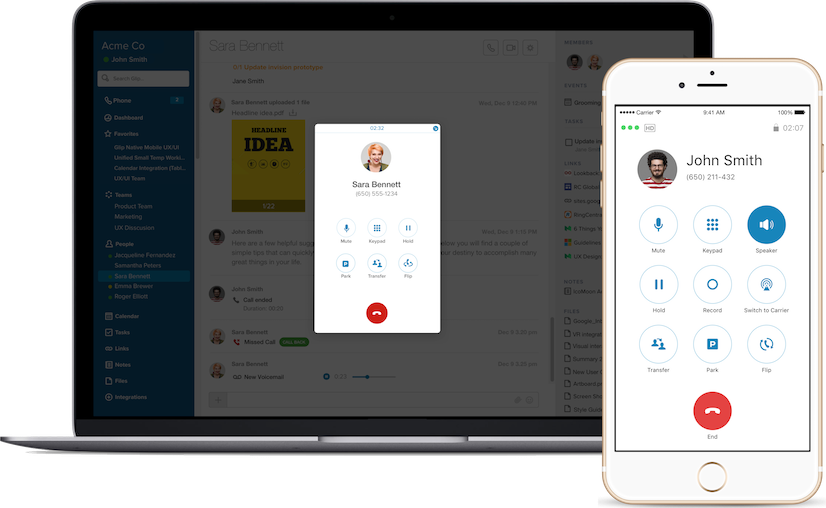 APPS
APPS
 APPS
APPS
 APPS
APPS
With the traditional office phone at death’s door for years, many companies have tried to bring voice together with email and innumerable other messaging and collaboration apps. Today RingCentral Inc. is taking another crack at it.
The 18-year-old cloud communications and collaboration company launched a number of new services, capped by a new user experience (pictured) for its flagship Office product. With the next generation of its flagship product, the Belmont, California-based company is promising to combine telephony, audio conferencing, messaging, fax and video meetings with a user interface consistent across smartphones, tablets and computers.
The idea, known as Unified Communications-as-a-service, is to allow people to use those capabilities in a more seamless way rather than in entirely disconnected ways like today, while replacing expensive and hard-to-maintain private branch exchange systems for traditional desk phones. For example, all in the same interface, you could talk to your boss, view the email she just sent, find a document she shared a few weeks ago on a team messaging app and do a video call with the prospective client she mentioned.
“It’s hard to get signal from the noise when the communications are all over the place,” Jose Pastor, RingCentral’s vice president of product management, told SiliconANGLE. “We built all the ways you want to communicate into one app. It declutters your life.”
Actually, it’s not yet all the ways you want to communicate. For now, it’s offering 40 readymade integrations of team messaging with business apps from companies such as Salesforce.com Inc., ServiceNow Inc., Zendesk Inc., Marketo Inc. and Atlassian Co. Inc.’s Confluence.
It’s not alone here. Upstart rival Dialpad Inc., for instance, also has integrations with Salesforce, Zendesk and ServiceNow as well as Google Inc.’s G Suite, with more to come. Pastor said there’s no reason many more won’t want to integrate with RingCentral. But it doesn’t yet have some very popular newer services such as Slack Inc.’s, to which it has a competitor, Glip, that it acquired in 2015.
RingCentral, which charges about $25 to $45 a person a month for its service, is looking to get a boost in its bottom line. In its fourth quarter ended Jan. 31, it outpaced slightly analysts’ expectations with a 3-cent profit before certain costs such as stock compensation, on a 25 percent rise in sales, to $104.5 million. But the results, including a net loss of 9 cents a share, underwhelmed investors. Its shares fell 4 percent in after-hours trading on Feb. 13, though as of Wednesday, they stood at $26.80 a share, not far off their 52-week high of $28.18.
The company faces some hard-charging competition that’s also aiming to join telephony with other communications methods in the cloud. That includes not only traditional rivals such as 8×8 Inc., Vonage America Inc., Microsoft Corp.’s Skype for Business and Cisco Systems Inc.’s Spark, as well as more recent startups. In January, Dialpad claimed 10,000 new customers in the previous six months, for a total of 35,000, including Uber Technologies Inc. and IBM Corp.’s Weather Channel unit and Netflix Inc. — though still a tenth of RingCentral’s customer base.
Moreover, no one company has yet combined all the disparate communications methods people use. Partly that’s because it’s not always clear that they all need to be combined, and often it’s done in a way that’s too complicated for what should be simple interactions. Even more, so many new communications and collaboration applications are sprouting up that it’s difficult to add them to existing systems. “It’s a tall order,” Pastor conceded.
RingCentral aims to help solve that problem with an expanded platform for application programming interfaces and software development kits that enable software developers to create new apps to integrate into RingCentral. The company is also providing interfaces for team messaging, chatbots and artificial intelligence. A sales rep, for example, might ask an AI-driven chatbot integrated with Salesforce what happened during the last interaction with a prospect.
The company, which has been targeting bigger customers to complement its longtime focus on small and medium-sized businesses, also is checking off enterprise boxes such as administrative controls and security. Also today, it’s announcing two real-time analytics features aimed at tracking quality of service and customer service interactions.
Support our mission to keep content open and free by engaging with theCUBE community. Join theCUBE’s Alumni Trust Network, where technology leaders connect, share intelligence and create opportunities.
Founded by tech visionaries John Furrier and Dave Vellante, SiliconANGLE Media has built a dynamic ecosystem of industry-leading digital media brands that reach 15+ million elite tech professionals. Our new proprietary theCUBE AI Video Cloud is breaking ground in audience interaction, leveraging theCUBEai.com neural network to help technology companies make data-driven decisions and stay at the forefront of industry conversations.